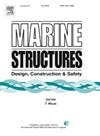Development and performance study of a multi-degree-of-freedom loading device for real-time hybrid model testing of floating offshore wind turbines
IF 4
2区 工程技术
Q1 ENGINEERING, CIVIL
引用次数: 0
Abstract
To address the challenges encountered in reproducing turbulent wind loads and scaling conflicts between the turbine and platform in traditional model tests for floating offshore wind turbines. This paper proposes a new real-time hybrid model test strategy with a multi-degree-of-freedom loading device. The design theories of the multi-degree-of-freedom loading device are thoroughly presented. Following this, a software-in-the-loop simulation system was constructed in MATLAB to develop simulation validation on the feasibility and load reproduction capability of the multi-degree-of-freedom loading device. This study addresses the challenges of scale conflicts and turbulent wind load reproduction in traditional model tests, providing a reference for the further development of real-time hybrid model testing techniques for floating offshore wind turbine. The results indicate that the thrust force error in the Fx direction is within 2 %, while the torque and bending moment errors in the Mx, My, and Mz directions are within 8 %. Finally, a hardware-in-the-loop testing system was established to conduct performance tests on the static and dynamic load reproduction capabilities of the multi-degree-of-freedom loading device. The dynamic load variation rate of the multi-degree-of-freedom loading device is 45 N/s, ensuring its capability for dynamic force changes at the scaled-down level. The reproducibility of aerodynamic loads on floating offshore wind turbine under steady wind and turbulent wind conditions by the multi-degree-of-freedom loading device is investigated. The maximum error in reproducing steady wind loads using the multi-degree-of-freedom loading device was found to be 3.7 %. In comparison, the maximum error in reproducing the average values of thrust force and torques in different directions under turbulent wind loads was 9.05 %. Within the 0–5 Hz frequency range, the aerodynamic loads in various directions achieved an energy recurrence rate of at least 99.2 %. It has been demonstrated that the thrust force, torque and bending moment of the floating offshore wind turbine can be effectively reproduced by the device, thereby mitigating the impact of scale effects on floating offshore wind turbine model testing.
用于浮式海上风力涡轮机实时混合模型试验的多自由度加载装置的开发与性能研究
为了解决浮式海上风力涡轮机在传统模型试验中再现湍流风载荷以及涡轮机与平台之间的比例冲突所遇到的挑战。本文提出了一种采用多自由度加载装置的新型实时混合模型试验策略。本文详细介绍了多自由度加载装置的设计理论。随后,在 MATLAB 中构建了软件在环仿真系统,对多自由度加载装置的可行性和负载再现能力进行了仿真验证。该研究解决了传统模型试验中尺度冲突和湍流风载荷再现的难题,为进一步开发浮式海上风电机组实时混合模型试验技术提供了参考。结果表明,Fx 方向的推力误差在 2% 以内,Mx、My 和 Mz 方向的扭矩和弯矩误差在 8% 以内。最后,建立了硬件在环测试系统,对多自由度加载装置的静态和动态载荷再现能力进行性能测试。多自由度加载装置的动态载荷变化率为 45 N/s,确保了其在按比例缩小水平上的动态力变化能力。研究了多自由度加载装置在平稳风和湍流风条件下对海上浮式风力涡轮机空气动力载荷的再现性。使用多自由度加载装置再现稳定风载荷的最大误差为 3.7%。相比之下,再现湍流风载荷下不同方向推力和扭矩平均值的最大误差为 9.05%。在 0-5 Hz 频率范围内,不同方向的空气动力载荷的能量重现率至少达到 99.2%。实验证明,该装置可以有效地再现浮式海上风力涡轮机的推力、扭矩和弯矩,从而减轻了规模效应对浮式海上风力涡轮机模型试验的影响。
本文章由计算机程序翻译,如有差异,请以英文原文为准。
求助全文
约1分钟内获得全文
求助全文
来源期刊

Marine Structures
工程技术-工程:海洋
CiteScore
8.70
自引率
7.70%
发文量
157
审稿时长
6.4 months
期刊介绍:
This journal aims to provide a medium for presentation and discussion of the latest developments in research, design, fabrication and in-service experience relating to marine structures, i.e., all structures of steel, concrete, light alloy or composite construction having an interface with the sea, including ships, fixed and mobile offshore platforms, submarine and submersibles, pipelines, subsea systems for shallow and deep ocean operations and coastal structures such as piers.
 求助内容:
求助内容: 应助结果提醒方式:
应助结果提醒方式:


